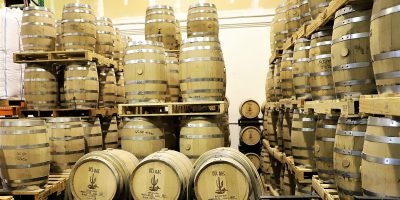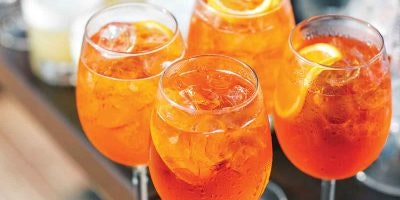Start thinking about American whiskey, and inevitably, the first thing to be conjured up will be Kentucky bourbon. Yet, whiskey’s presence in the United States goes back far deeper, and to understand the industry, its massive growth, and the direction it’s heading, it’s essential to go back to its roots.
The history of American Whiskey
There’s no better place to start than with the country’s first president, George Washington, and his Mount Vernon estate, a key historical site yet also a still-functioning outpost along the American Whiskey Trail.
George Washington opened his distillery in 1797 after being urged on by Scotsman James Anderson, his farm manager. Ironically, just a few years prior, Washington had led a 13,000 person militia to personally quash the Whiskey Rebellion, over the country’s unpopular new whiskey tax.
Whiskey was fast emerging in the wake of the Revolutionary War; importing rum, or purchasing the molasses to make it, both became prohibitively expensive, especially with an abundance of rye, along with corn and wheat, available domestically to be used in its stead. Not only would Americans be drinking more tea today if still under British rule, it’s a good bet that rum would have retained a lion’s share of the spirits marketplace as opposed to whiskey.
By 1799, George Washington’s distillery was the largest in the nation, producing nearly 11,000 gallons of unaged rye whiskey, which doubled the profit for his entire plantation. He died in December of that year though, and it didn’t take long for the operation to crumble in his absence. In 1814, the distillery burnt down, and it wasn’t rebuilt until 2007. Today, the George Washington Distillery painstakingly produces whiskey with the tools and technology that were used in Washington’s era.
Corn Whiskey Emerges
Rye whiskey remained at the forefront, until once again, American whiskey evolved as a byproduct of other circumstances. The “corn writ”, as explained by Woodford Reserve master distiller Chris Morris, encouraged settlers to move to Kentucky, which at the time was still a portion of western Virginia.
They received land for $2.40/acre in exchange for living on it for at least five years, and growing corn. These farmers, many of whom were of Irish and Gaelic descent, suddenly had excess corn on hand. What to do with it? It became the dominant component of what was being used to make whiskey, and what would eventually become known as bourbon. It just so happened that Kentucky’s now famous limestone-rich water supply was ideal for distilling tasty spirits, too.
Aging in charred oak: A happy accident
Whiskey though was still largely unaged, until circumstances shaped its evolution yet again. The Louisiana Purchase in 1803 opened up shipping routes, and suddenly farmers and distillers could more easily move their whiskey wares to other portions of the country.
To do so, they had to transport the whiskey in barrels, the best of which were made with oak. The insides of those oak barrels were also charred, as cooperages needed to heat the wood to bend it into shape. By the time the whiskey arrived at its destination, the whiskey was colored and had new flavors – some level of aging had occurred.
The usage of charred oak barrels for aging American corn whiskey was another in a series of happy accidents. The first recorded mention of aged bourbon, known as “red whiskey”, is found in 1821. Whiskey continued to take hold in Kentucky and across the country and became the nation’s spirit.
Prohibition & Its Aftermath
A century later, in 1919, Prohibition smashed the legal American whiskey industry, but it didn’t completely stop it. A handful of distilleries were able to remain open with medicinal licenses. Prescriptions were doled out in the millions, good for a pint of whiskey per 10 days to cure what ails ya.
Other distilleries shuttered their doors but stored their whiskey for later usage. Some simply bided their time and looked ahead. Jim Beam actually purchased the land which would become his distillery two years into Prohibition, using it as a rock quarry to make ends meet until repeal came. Just months later, the distillery was built, open and operational.
After Prohibition ended, the usage of new charred oak barrels for making legally defined bourbon whiskey became mandatory in 1938. The mandate was much less about ensuring the quality of the whiskey, but instead, was put into place to protect jobs in the timber industry.
Still the quality of American whiskey was a concern. “We realized repeal was worse than Prohibition,” says Bill Samuels Jr. of Maker’s Mark. American producers were now lagging behind those from other areas of the world. “It was an onslaught.” Distillers reopened by the hundreds, but aging was minimal, quality was low, and corners were being cut.
The emergence of bonded whiskey
While the Bottled-in-Bond Act was first passed in 1897, bonded whiskey became more prominent in the post-Prohibition market. “It was proof that the liquor was what it was said to be, because it was bottled and produced under government supervision,” says Jim Beam master distiller Fred Noe. “You knew what was in the bottle.”
Across the industry, quality was improving, and many of the big names still present today, from Jack Daniel’s to Jim Beam to Wild Turkey, grew and thrived. There would be hiccups, as tastes and preferences changed, and the industry took a downturn in the 1970s. But it has never been stronger than it is right now, with 28.5% growth in U.S. sales over the past five years according to the Distilled Spirits Council of the United States (DISCUS), and a seemingly insatiable thirst for bourbon and American whiskey both domestically and around the world.
There’s an estimated 700 craft distillers across the country today, stretching far and wide beyond Kentucky, and like much else, America’s penchant for both making and drinking whiskey can be traced back to the country’s forefathers, and an intriguing step-by-step evolution born of necessity and happenstance.
Americans made rye whiskey when rum was too expensive. They turned to corn whiskey as they moved to Kentucky to grow corn as a crop. They began aging whiskey in barrels to ship it. Barrels which had been charred imparted flavor. Prohibition halted the industry, but in its wake, quality emerged and the modern business of American whiskey took shape.
Ready for a bottle of American Whiskey?
With Distiller, you’ll always know what’s in the bottle before you spend a cent. Rate, Review, and Discover spirits! Head on over to Distiller, or download the app for iOS and Android today!



